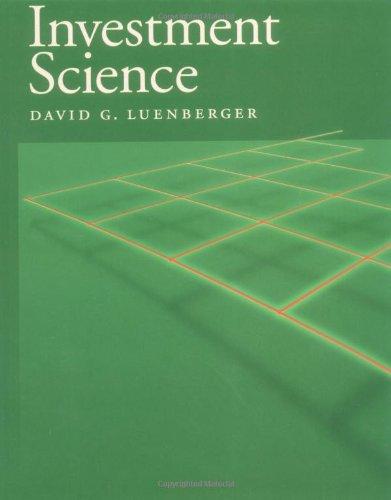Question
1. Use the futures prices (in cents) of live hogs at the end of June 2021 to calculate the expected growth rate in prices between
1. Use the futures prices (in cents) of live hogs at the end of June 2021 to calculate the expected growth rate in prices between September and November
| July 2021 | 61.20 |
| September 2021 | 59.60 |
| November 2021 | 61.70 |
| January 2022 | 62.67 |
| March 2022 | 63.42 |
| May 2022 | 63.40 |
2. Use the futures prices in problem 1 for this problem. Suppose that a certain breeding decision would involve an investment of $125,000 with expenditures of $15,000 in 3 months, 6 months, and 9 months. The result is expected to be more hogs available for sale at the end of the year. There are two major uncertainties: number of extra hogs available for sale and the price per pound. The expected number of pounds is 250,000 and the expected price of hogs in 1 year is 63.40 cents per pound. Assuming that the risk-free rate of interest is 10% per annum, what is the value of the investment (in thousands of dollars)?
3. Suppose that the principal of a synthetic CDO is $125 million. The equity, mezzanine, and senior principals are $10 million, $25 million, and $90 million respectively. Which tranche(s) is responsible for payouts of $7 million due to defaults by companies in the portfolio? Which tranche(s) is responsible if those payments rise to $14 million?
4. Suppose two firms enter into a 4-year credit default swap on in March 2021. Assume the notional principal is $125 million and the buyer agrees to pay 80 basis points per annum with payments being made quarterly. How much is each quarterly payment for the buyer and how much will the buyer pay after four years of quarterly payments if there is no credit event?
5. In March 2022, General Electric and JPMorgan Chase enter into a three-year OIS. GE agrees to pay JPMorgan Chase a fixed rate of 4% every three months on a notional principal of $120 million. JPMorgan Chase agrees to pay GE the three-month SOFT floating reference rate on the same $120 million notional principal. For General Electric, what are the floating cash flows received, fixed cash flows paid, and overall net cash flows with the following SOFR rates:
2.15; 2.65; 2.90; 3.15; 3.20; 3.45; 3.60; 3.80; 3.95; 4.05; 4.20; 4.35
6. Consider an investor who purchases a European call option with a strike price of $105 to purchase 100 shares of a stock that is currently priced at $100. The expiration date of the option is in three months and the price of the option to purchase one share is $5. What is the initial investment? What is the loss for the investor if the stock price is less than the strike price and the option is not called? What is the gain/loss if the stock prices rises to $106? What is the gain/loss if the stock prices rises to $117?
7. Consider an investor who purchases a European put option with a strike price of $75 to sell 100 shares of a certain stock. Current stock price is $68. The expiration date is in three months and the price of an option to sell one share is $6. How much is the initial investment? What is the loss for the investor if the stock price is more than the strike price and the option is not called? What is the gain/loss if the stock price is $65 dollars? What is the gain/loss is the stock price is $74 dollars?
8. What is the lower bound for calls on a non-dividend-paying stock with a current price = $25, strike price = $22, continuously compounded risk-free rate of interest = 10%, and time to expiration = 3 months
9. Using the following prices for 6-month European calls, explain how an investor could create a butterfly spread and what are the potential gains/losses?
| Strike Price ($) | Call Price ($) |
| 40 | 12 |
| 45 | 10 |
| 50 | 8 |
10. Explain the difference between bull spread and bear spread strategies? What is a calendar spread? When it comes to combination spreads, how do strips, straps, and straddles differ from one another?
Step by Step Solution
There are 3 Steps involved in it
Step: 1

Get Instant Access to Expert-Tailored Solutions
See step-by-step solutions with expert insights and AI powered tools for academic success
Step: 2

Step: 3

Ace Your Homework with AI
Get the answers you need in no time with our AI-driven, step-by-step assistance
Get Started


